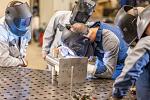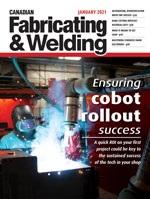Associate Editor
- FMA
- The Fabricator
- FABTECH
- Canadian Metalworking
What it means to get lean
A structured lean thinking methodology drives improvements
- By Lindsay Luminoso
- January 27, 2021
- Article
- Management
Lean is a word that is often misunderstood when companies are thinking about improving their operations. It is not always clear what they mean when they say they are going lean. It can be different things to different people, especially as no lean standard exists as it does for quality, like the ISO standard.
Historically speaking, Toyota is considered the father of lean manufacturing and developed hoshin kanri planning, which is an element of a lean framework that takes input from a company’s strategic plan and deploys key improvement objectives level by level down throughout the organization.
"Lean is made up of many elements like total productive maintenance, quick change, containerization, pull system, errorproofing, 5S, machine layout, level scheduling, and many more," said Bill Neeve, president, Cycle Time Management (CTM), Kitchener, Ont. "So, it can be quite overwhelming to an organization that’s first looking at it and trying to figure out how to implement it in their company. CTM has always looked at lean implementation as a holistic opportunity for any company rather than a piecemeal program, where they try to implement it in increments."
Neeve started CTM, a lean training and facilitation firm, in 1986 to help companies understand and effectively implement lean concepts. He and the team apply Toyota’s hoshin planning and link it to a methodology to deploy various lean strategies across an organization.
"We’ve helped companies implement lean operating practices over the last 35 years," said Neeve, "so we feel we’ve got a pretty good position and understanding of what it takes to implement and transition from traditional manufacturing to apply lean thinking."
The manufacturing landscape has changed significantly over the last several decades. Through the years, there has been a shift in the size of companies. Many large manufacturers no longer exist, and instead small to medium-size enterprises (SME) have taken their place. However, the companies that have made a significant investment in lean over the last decades, names like Magna and Linamar, continue to be successful in the market. Large firms have the capital and the manpower to implement lean, which initially can be quite an expensive undertaking.
"The small companies can’t always afford to pay consultants or trainers," said Neeve. "It’s very expensive. But that’s why companies should look at available grant programs. In 2015 Prime Minister Trudeau put in place a grant program to help these types of organizations that need a hand for something like lean. Companies that are interested should certainly look at these and other programs and do what they can to make it happen."
Holistic ApproachThrough his years of experience, Neeve has found that many companies talk about implementing lean and think that they can take one aspect, like 5S, apply it on the shop floor, and be done. But that’s not lean. Instead, shops need to take a holistic approach and move through a thorough transition with support from the top and a methodology to work it all the way down through the company. And that’s where CTM comes in.
"Most consulting groups, if they come in to try and help you with improvements, look at the organization and how it’s structured (vertically) only, not how the processes run from end to end (horizontally)," said Neeve. "We started in 1986 with the horizontal approach, which was relatively new at the time, and continue with this approach to this day." Its top-down for goal and key objective setting and cross-functional for understanding process at the same time."
Lean is all about waste—waste of overproduction, waste of transportation, waste of waiting, waste of motion, waste of overprocessing, waste of inventory, and waste of defects. These various types of waste are found in all traditional organizations, and implementing lean can reduce or eliminate them.

A value story map, which examines how the company functions horizontally, can help flush out any inconsistencies and demonstrate how to make effective changes on the shop floor.
Implementing lean helps shops shift from taking 10 steps when only one is needed. And in order to do that, shops can work with companies like CTM to help them understand their high-level value streams. Going through their processes, they can break the company down into core value streams and then sub-value streams. This provides a better picture of the flow, whether good or bad, and exposes bottlenecks, scheduling problems, and waste.
"Lean to me is really made up of three major things: people, process, and automation," said Neeve. "Unless you start at the strategic level, apply hoshin planning deployment, and think through all three aspects, you’ve missed the opportunities. If you jump right in at the project level and work on random improvements in one or two areas, you may very well just shift the issue or bottleneck to another part of the shop. You won’t achieve anything. In fact, you can make things worse. You have to balance those three as you go through the lean transition."
CTM works with a company to identify a strategy that is both short and long term. It is important for a shop to know where it wants to go in the market, what it expects for the next five years, and what levels of efficiency that it would like to attain going forward. For Neeve, the first place to start is at the top.
People
Neeve explained that one of the biggest drivers for successful lean improvements is senior management. He often sees owners or presidents of companies read about lean and think that it’s worth implementing. But they hand it off to other members of the management team or do not truly understand what is involved and then often abandon the effort.
"It’s not just about senior management supporting the program," said Neeve. "We need a senior team that truly understands lean and quality for any implementation to be successful. They need to lead, and the way they do this is by accessing new tools, developing a dynamic strategy, and integrating it with hoshin planning."
By doing this, the senior management has a role to share the KPIs that need to be achieved to meet company goals and drive that information down level by level. It’s so important to have a total company communication system embedded in the facility.
Shops obviously need people to buy in and participate, but if they do not have leadership at the top, workers will not have the necessary instruction and skills and will continue to work using traditional operating practices. Providing the necessary tools and knowledge to all members within an organization can eliminate the fear and help people see the value in transitioning to lean.
Shops don’t often hit the reset button and are comfortable working a certain way. Providing proper training can help identify areas for change and find the most effective ways of doing so. Beyond good training, Neeve said that communication is key, and it comes from the top.
Process
In terms of process, it is important to map out the entire company’s current state and look at all the high-level value streams. This will give management a snapshot of various aspects like inventory levels, bottlenecks, cycle times, work flow, and changeovers.
"I have gone into factories, even today, that take upwards of eight hours to change over a die on a 20-ton press," said Neeve. "A company that is applying lean and has spent time reducing changeover time may be able to get the exact same press die changeover down to 10 minutes. And every minute that a shop spends working on setup means it isn’t producing parts. Getting a methodology in place to teach people how to reduce this time can also reduce costs, increase revenue, and improve flexibility."

Providing the necessary tools and knowledge to all members within an organization can eliminate the fear and help people see the value in transitioning to lean.
This is just one example. It’s also necessary to teach people where, how, and why improvements should be made. If management’s goal is to reduce costs on the shop floor by 10 per cent, and workers don’t know what 10 per cent looks like in the grand scheme of things, then how are they supposed to contribute and effect change? Communication about process goals and improvements is necessary. That’s where all the hoshin tools come into play.
Getting people to start looking at a bigger picture beyond their own workspace is a good start. This is why taking a horizontal approach to processing is needed, Neeve said. It will help companies better understand how and why various aspects of the process are impacted. And it is only when shops can identify where issues are that they can then apply the right methodology and the right level of automation to make a process more efficient, with short cycle times, while cutting overall costs.
Automation
"I have seen so many examples of shops trying to automate their way to a leaner company," said Neeve. "You need to simplify your processes using lean methods, then automate to gain even more efficiency. I have gone into so many facilities where they have bought a new piece of equipment and just stuck it on the floor. There is no automation strategy that links processes end to end. It’s so disjointed and can often lead to bigger bottlenecks and process flow errors in other parts of the shop."
Automation has been developed to help improve various aspects of the manufacturing process and beyond, such as shorten the time to change over from one product to another, which is great. But it is important to recognize when and how automation is needed and develop a strategy that describes how the shop will operate going forward.
"If you look at the company, not how it’s structured, but how it operates horizontally from one end to the other, you can better see the flow, how the product moves from order to delivery," said Neeve. "That’s where a value stream map comes into play and can help a company flush out any inconsistencies or issues hidden in processes. That is where it comes back to people’s input; the team members can provide valuable insights into improvements back to management."
Automation helps make life easier—most of the time. Purchasing automation in isolation is not a good idea. Implementing a lean strategy first will help shops find ways to better use automation or automate processes that they will benefit from.
Get Started
"It’s never too late to start getting your head around lean thinking," said Neeve. "People very rarely hit the refresh button on their companies. It’s hard to see how sitting down with a cross-functional group, exploring issues and talking about the day-to-day happenings of a company will add value. But it can be very rewarding to see a company take the information gleaned from these discussions and transform it into significant change. Lots of shops don’t think they can change, but they can really become more efficient under the guise of lean."
Neeve noted that right now is a good time to start. This is especially true with the pandemic reducing the workforce and production capacity in many shops.
"One of the benefits in starting during these difficult times is it will help a shop to figure out the best and most profitable way to move forward when things do pick back up again," said Neeve. "The pandemic has exposed many areas of waste and areas of improvement, so by implementing lean, a shop can better position itself going forward."
The pandemic has also made e-learning much more widely available. Getting workers involved in online training and lean certification e-learning can be a great way to start transitioning to lean.
"There’s no better time to look at your processes and put a strategy together than now," said Neeve. "If you are currently producing product at reduced quantities, it might be worth exploring how to get people together and evaluate how the shop is operating and how you want to operate when we move out of the pandemic. Start training team members now, not down the road. It’s easy to think that there is never a good time, but continuing to operate in a traditional manner will not boost productivity or profits, so there really is no time like the present."
Associate Editor Lindsay Luminoso can be reached at lluminoso@canadianfabweld.com.
William (Bill) Neeve is president of Cycle Time Management Inc., 226-747-7475, billneeve@leancycletime.com, leancycletime.com.
About the Author

Lindsay Luminoso
1154 Warden Avenue
Toronto, M1R 0A1 Canada
Lindsay Luminoso, associate editor, contributes to both Canadian Metalworking and Canadian Fabricating & Welding. She worked as an associate editor/web editor, at Canadian Metalworking from 2014-2016 and was most recently an associate editor at Design Engineering.
Luminoso has a bachelor of arts from Carleton University, a bachelor of education from Ottawa University, and a graduate certificate in book, magazine, and digital publishing from Centennial College.
subscribe now


Keep up to date with the latest news, events, and technology for all things metal from our pair of monthly magazines written specifically for Canadian manufacturers!
Start Your Free Subscription- Trending Articles
Class is in session for college connections

BlueForge Alliance partners with Nuts, Bolts & Thingamajigs to develop Submarine Manufacturing Camps

Engine-driven welding machines include integrated air compressors

Orbital tube welding webinar to be held April 23

Portable system becomes hot tech in heat treatment

- Industry Events
ZEISS Quality Innovation Days 2024
- April 15 - 19, 2024
Tube 2024
- April 15 - 19, 2024
- Düsseldorf, Germany
CTMA Economic Uncertainty: Helping You Navigate Windsor Seminar
- April 30, 2024
- Windsor, ON Canada
MME Winnipeg
- April 30, 2024
- Winnipeg, ON Canada
CTMA Economic Uncertainty: Helping You Navigate Kitchener Seminar
- May 2, 2024
- Kitchener, ON Canada
















